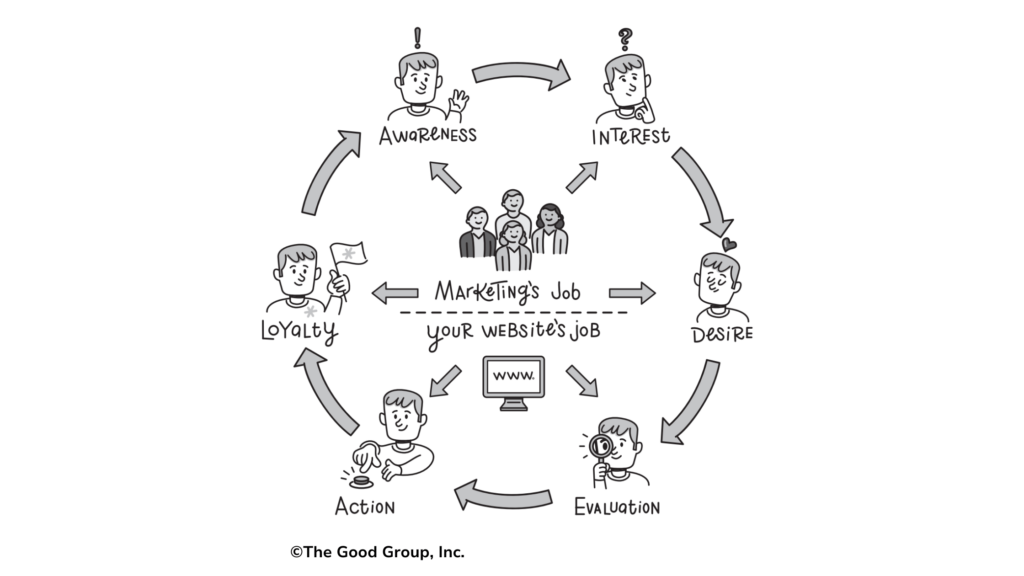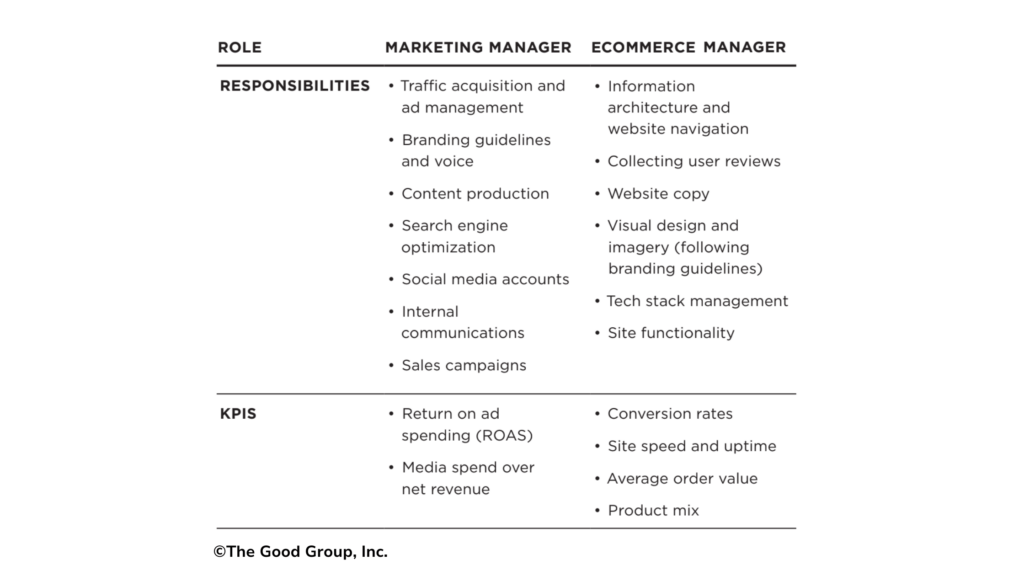
Your Ecommerce Team Should Be Part Of Your Sales Department
Leave marketers to do what they do best: drive traffic to your site and build a beloved brand. Then, your ecommerce managers can focus on building an on-site user experience that converts.
This article is based on an excerpt from my book, Opting In To Optimization. Inside is a set of principles that will help ecommerce leaders capitalize on unprecedented market demand and build sustainable, thriving businesses. Get your copy here.
There is an aspect of “old age” ecommerce thinking that is particularly troublesome to me.
Many brands I meet treat their ecommerce site as a marketing channel and put it under a marketer’s jurisdiction.
You may wonder, “What’s so problematic about this?”
It’s problematic because marketers tend to approach a website from a brand perspective. They have goals, priorities, and key performance indicators (KPIs) that are brand-centric.
In reality, an ecommerce site’s job is to convert visitors into customers and leads. The website needs customer-centric goals because it’s there to serve the customer’s needs. So why don’t ecommerce team structures fall under the sales department?
In this article, I’m diving into why you should consider rearranging your organizational structure so that marketing and ecommerce managers can excel in their corresponding roles.
The POV Shift: Moving Ecommerce Team Structure From Marketing To Sales
When a marketer is in charge of an ecommerce site, business goals are prioritized over customer goals.
For example, when marketers write product descriptions, they often sell the lifestyle or overall brand vision of the company but not how the particular product meets the visitor’s individual needs.
Think “our classic logo polo” (self-serving) versus “our polo is made of soft organic cotton that is machine washable” (shares a few compelling reasons to buy).
When you extrapolate this brand-centric approach to every other part of an ecommerce site, the result is an underperforming channel that values style over substance.
So what’s a better option?
Consider what would happen if ecommerce sites and the ecommerce team structure fell under the sales department instead.
The user experience would be completely different (and, I’d argue, for the better!). Whereas marketing focuses on generating awareness, interest, and desire, sales focuses on conversions—getting out of the way once the visitor is ready to buy. This aligns much more closely with what your online business should be doing.

From many years of working with ecommerce brands, both large and small, I’ve noticed the most successful brands acknowledge this split and actually do put their ecommerce site under a more sales-focused role.
In many cases, this means a brand has at least the following roles:
- A marketing manager responsible for creating interest and recognition and driving good visitors to the website.
- An ecommerce manager who is responsible for what happens when the visitor arrives. This role operates more like sales than marketing.
These separate but collaborative roles work together (like in the circular image above) to effectively get a visitor to the site and then get out of their way once they’re there.

What Is The Difference Between An Ecommerce Manager And A Marketing Manager?
At first glance, these roles sound pretty similar. But done well, they have a different set of responsibilities and KPIs:

Although brands differ on some role specifics, such as who creates the copy for each page on the website, the consensus is that the website is the ecommerce manager’s domain.
Jeremy Horowitz, previously ecommerce manager at LuMee (a Case-Mate brand and distributor of phone cases) and now partner at Messenger Mastermind, says, “As the ecom manager, I was much more focused on the sales side of things…CRO, promotional calendar, website/tech stack management.” He notes the website was the ecommerce manager’s jurisdiction, though marketing played a heavy role in copy.
At Kuru Footwear, a growing brand, the website is also under an ecommerce manager.
They have various channel managers on the marketing side, but former CMO Sean McGinnis says when it comes to the website, “every design choice and every optimization is [the ecommerce manager’s] call.” As a result, site uptime, speed, and site conversion rate are the ecommerce manager’s responsibility as well.
Both of these brands—as well as some of the most successful brands The Good works with—recognize that yes, a marketing manager plays a critical role in driving the target audience to the site and amping up their interest before they get there.
But once the visitor arrives, a handoff occurs. The visitor has crossed a boundary line, so to speak, and entered into the ecommerce manager’s realm.
Other Reasons An Ecommerce Site Should Be The Ecommerce Manager’s Domain
Even for small, emerging brands with limited resources, hiring a dedicated ecommerce role for the house team whose job is to connect marketing needs with user needs, user research, and website optimization will result in a more focused website experience.
Expecting a marketing manager to pull off a successful marketing strategy and a successful conversion rate strategy is an enormous, unrealistic ask.
You wouldn’t expect an ecommerce expert to know the ins and outs of executing a successful marketing strategy. So why assume a marketer could do the same in an ecommerce role?
Marketers who are expected to do both will either pick one out of necessity or stretch themselves too thin across both domains (i.e., do both poorly).
At The Good, we see this conflict in reporting metrics, where marketing managers turn canaries into KPIs.
The Canary Theory
Starting in the early 1900s, miners took caged canaries down into the shafts. Canaries are more sensitive to gases like carbon monoxide (deadly in high doses) than humans. If a canary suddenly seemed ill (or worse, died), miners knew it was high time to hightail it back to open air.
In reporting, modern-day canaries are metrics that indicate some larger, dangerous issue is at work. Take “time on page” or “time on-site.” If you’re testing different landing pages and visitors are bouncing after nine seconds, you may have a terrible top-of-page experience. Alternatively, this metric can be a clue to a larger mystery.
In one instance, the team at The Good noticed visitors were somehow arriving on the cart page from every kind of channel.
But this was supposedly impossible; you can’t get to the cart through paid search. The team found that visitors spent a lot of time on-site doing research. Then they moved offsite to find missing information or a coupon code.
By the time the visitor returned, their session had timed out. It also appeared as if they just arrived on the cart page.
Time on page is useful as a canary. But marketing often treats this and similar metrics, such as pageviews, as KPIs.
This isn’t throwaway data, but it doesn’t reveal nearly as much as return on ad spend (ROAS), average order value (AOV), conversion rate (CR). Other essential ecommerce metrics that reveal a good deal more about how the customer is experiencing the site.
Get Your Ecommerce Site Out Of The Hands Of The Marketing Team
It’s time to rethink your ecommerce team structure and priorities of ecommerce management.
I know for some brands, I am proposing a critical shift in managing your team and ecommerce sites. But, I am confident that it will help you achieve your ultimate goal of converting more site visitors.
Brands need to recognize the distinct responsibilities of marketing managers in driving traffic and interest. At the same time, understand ecommerce managers’ role in optimizing the website for seamless transactions. This way, they can create a more efficient and effective online presence.
Ecommerce sites should have a dedicated team (or team member) that reports to the sales department rather than marketing. This shift aligns the website’s purpose with conversion-focused goals, ensuring that the user experience caters to customers who are ready to make a purchase.
Enjoying this article?
Subscribe to our newsletter, Good Question, to get insights like this sent straight to your inbox every week.

About the Author
Jon MacDonald
Jon MacDonald is founder and President of The Good, a digital experience optimization firm that has achieved results for some of the largest companies including Adobe, Nike, Xerox, Verizon, Intel and more. Jon regularly contributes to publications like Entrepreneur and Inc.